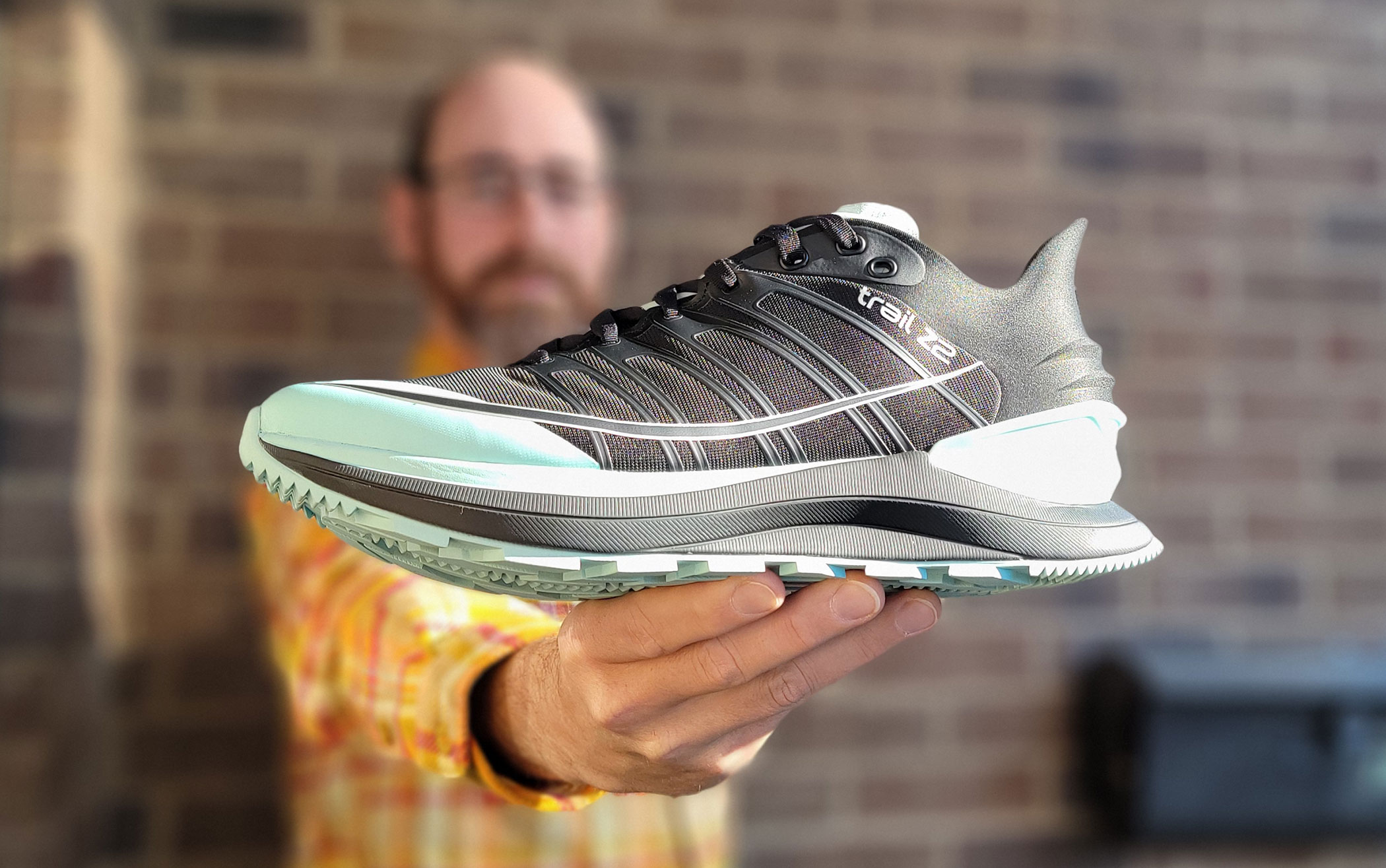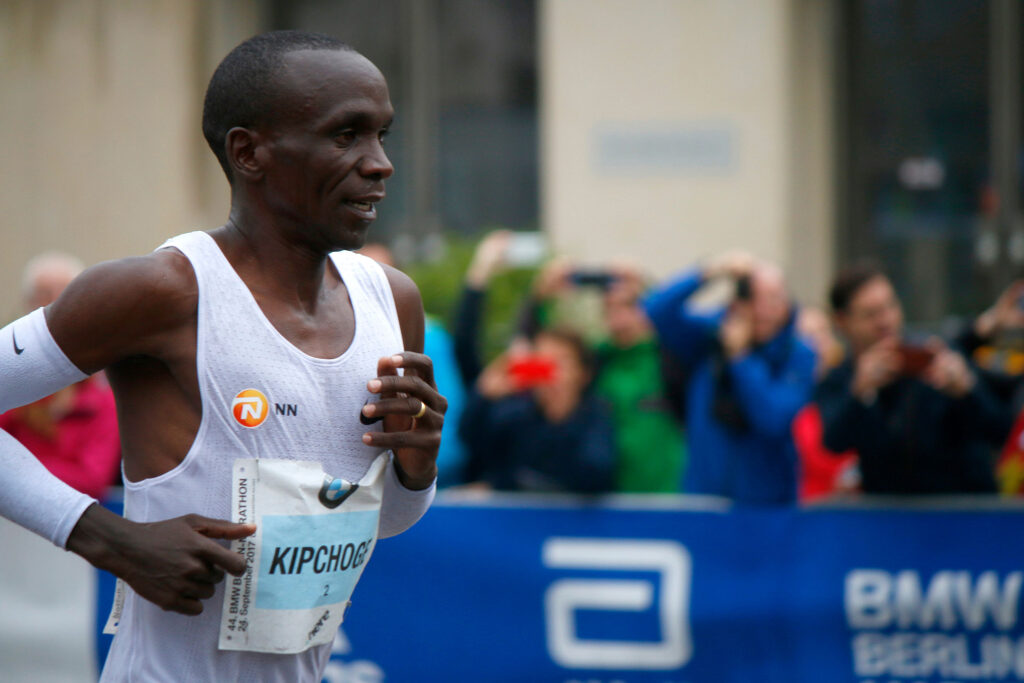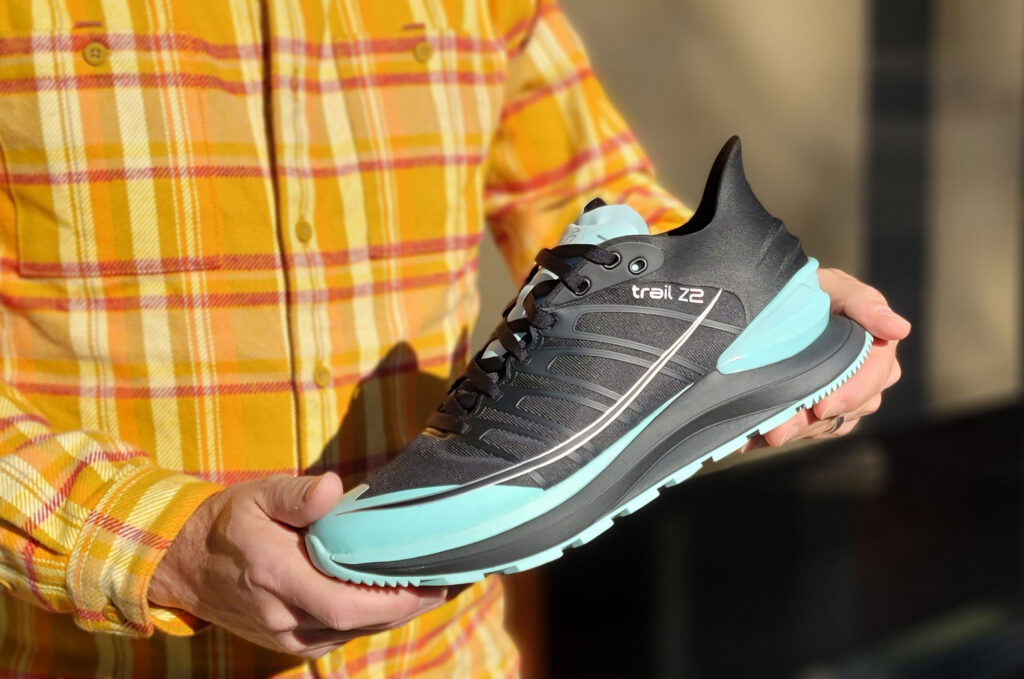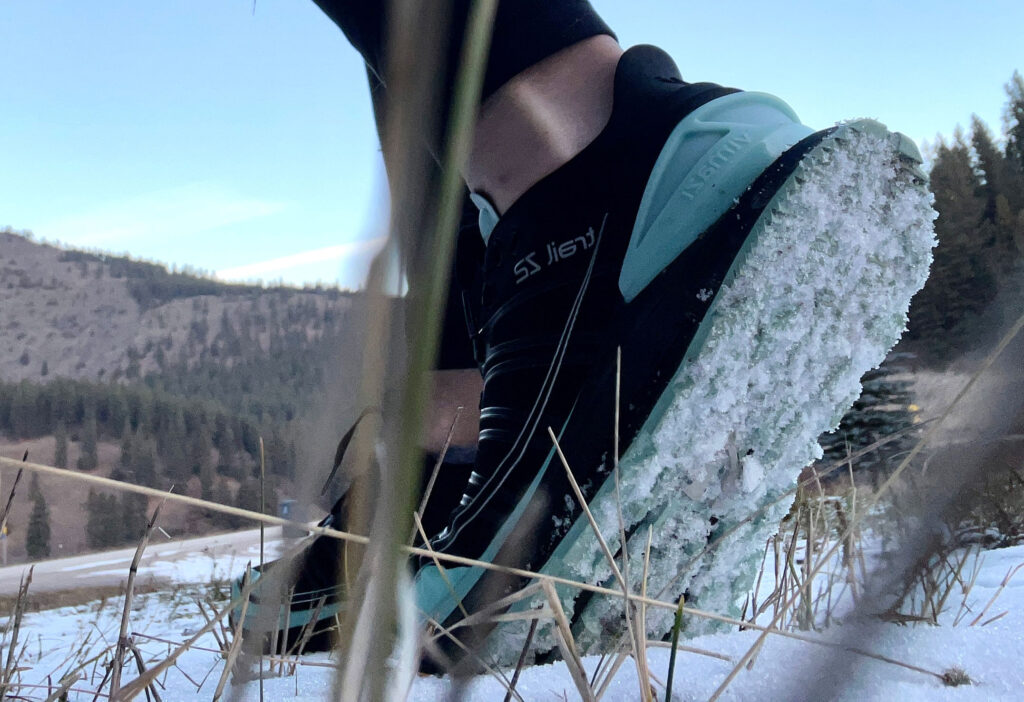
Image by Bay Roan Creative
If you’ve ever ventured out on a trail run, you know how refreshing, challenging and fun traversing on a rugged stretch of trail can be. You also know you need the right shoes for the job. Just like tires on a car, shoes matter. Choosing the wrong footwear for the trails can have significant consequences beyond mere discomfort — like slips and falls, foot fatigue and increased risk of injury. In a world of innovation, shoe technology continues to evolve, let’s get Unpacked with Vimazi and see how the brand’s engineers are working to advance running footwear.
Origin Story
Vimazi founder Scott Tucker ran his first marathon in 1995. During that same time, he was heading up Montrail’s trail running shoe development — specifically working on the Vitesse, a nimble running shoe with a wide shock absorbing base.
After his first marathon, Tucker focused on running 50k ultra marathons, which led to Ironman Triathlons and then to his ultimate quest to complete each of the six major marathons in under three hours. He achieved that feat and went on to run about 20 marathons.
“Whether the event was on road or trail, my quads always felt hammered part way through,” Tucker said. “I know I’m not alone in this, so in addition to my geeky obsession with the physics of running, I wanted to make shoes that would ease my pain. I wanted to make shoes that would reduce the fatigue I experienced so that I would be better able to maintain my pace in the latter half of a marathon.”
Nike’s Breaking2 documentary aired in 2017 and inspired Tucker.
In the film, staff at the Nike Sport Research Lab collaborated with endurance superstar Eliud Kipchoge and other testers to help identify the exact specs needed for each runner to perform that their peak efficiency.

Eliud Kipchoge is among the world’s top marathon runners. (Image by 360b, Shutterstock)
Kipchoge dreamed of breaking the two-hour marathon barrier. While wearing the Nike ZoomX Vaporfly 4% shoes — the result of this Nike project — the Nike team chronicled Kipchoge’s first sub-two-hour attempt. Although Kipchoge missed his mark by 26 seconds, that attempt and everything he learned from the experience helped him realize his dream two years later.
“I knew that when you’re dealing with a system that repeatedly expends energy (like a running stride) that a spring has to be in resonance with the system for any energy that goes into the spring to be returned to the system,” said Tucker. He thought it was unlikely that Nike’s product engineer team figured out exactly how to build a shoe for Kipchoge that would do this, but perhaps they got lucky.
“If I could figure out how to build such a shoe intentionally, I could make such shoes for the masses,” he added. “But I soon discovered that this was an impossible undertaking, because it would violate the laws of physics. This includes Kipchoge and his shoes.”
In simple terms, Tucker explained that running is different from bouncing on a trampoline. When you bounce, your body adjusts to the trampoline’s rhythm because it’s slow and gives you time to sync up. Running, on the other hand, happens too quickly for a shoe’s rhythm to match your stride. No matter the shoe’s design or foam, he said it can’t sync with your movements due to the fast pace of running.
There are several reasons for this, but the main point is that it’s a physics limitation, and you can’t break certain rules.
“In discovering the impossibility of making an energy-return shoe,” Tucker said, “I discovered you can make a shoe that reduces impact stress without becoming a wobbly thing that might increase stress on your knee and ankle joints (side to side).”
Vimazi in the Beginning
Back in the 1970s, Tucker was one of those young students with stage fright. “Maybe it would be diagnosed as anxiety now? I don’t know,” he said. “I would freeze up, my mind would go blank and I would feel panicked. I was, am, a slow reader. This meant that studying took longer.
Ultimately, this led Tucker to cut off graduate school in Atmospheric Science after a master’s degree and enter the job market.
“The thing is, it didn’t damp my curiosity about the world. In 2017, when I started thinking about shoes and harmonic resonance, I knew that if I was going to make headway in understanding running forces, and I couldn’t just find it in the literature, because nobody had figured it out,” he said.
“I would have to confront my stage fright and fear that I wouldn’t be able to do it. (because if you can’t finish, why begin?)”

Image by Suzanne Downing
Following the Nike documentary and with the mindset of making a shoe that reduces impact stress without becoming wobbly, Tucker got to work. Through research and testing, Tucker and his team figured out how a runner controls their motion so they stay upright and can navigate through tricky terrain like trails with apparent ease. And in doing so, they figured out the theory that predicts the forces under your feet according to what you’re doing (like according to your cadence, stride length and the terrain — even what happens with wind and elevation.)
That’s when Tucker invented the Vimazi sole design with a soft heel relative to the much firmer forefoot FastPod, which was so different from other dual density shoes — and he applied for a patent on it.
Four years later, the first Vimazi running shoe prototype — the Vimazi Z30 — was ready for testing.
View this post on Instagram
The Z30 prototype shoe, specifically tuned to reduce the fatigue that comes with half marathons and full marathons, was specifically designed for runners in the 3:00 to 4:30 min/km pace zone with stable propulsion responsiveness to give runners long-distance protection from pounding and lateral stress.
Tucker personally field tested the Z30 in a marathon in 2021. “It was super exciting to actually feel the difference,” said Tucker, who went on to test the next model — the Z40 — shortly after while pacing the 3:30 min/km pace group at the Portland Marathon.
“I enjoyed ‘lively legs’ through to the end,” he said, and added that his personal experience in marathons with the Z30 and Z40 shoes left no doubt that the additional shock absorption of those Vimazi shoes made a positive difference.
“The field testing wasn’t limited to me or just running marathons,” Tucker said. “But the experience is part of what motivates me to shoot for the stars with this business. When people say it takes twice as long and costs twice as much, they are not kidding!”
After putting the finishing touches on the first two Vimazi running shoes, Tucker and his team delivered the first Vimazi shoes to market in the spring of 2023.
“The reason we launched with road shoes is because there is such a significant difference in the impact and propulsion forces as you run faster,” Tucker said.
View this post on Instagram
“I thought the idea would make intuitive sense to people. Trail and walking shoes were always part of the plan, but I guessed that the market would react strongest early on to the road shoes,” he said. “In retrospect, the noise and confusion surrounding super shoes has drowned out our message in road running. However, the trail runners don’t have to compete with super shoes, so the stress reduction message can ring through. …
“One of the most positive things that has happened to me over the past six years has been conquering anxiety. Being the first to figure out the physics of running (and locomotion in general) is the cherry on top.”
The Tech & Biomechanics
Drawing from over 25 years of experience in making and testing running shoes, Tucker emphasized the symbiotic relationship between craftsmanship and performance. This hands-on, experience-driven approach allows the Vimazi team to continuously refine designs, creating footwear that not only looks good but significantly enhances the runner’s experience.
“Being a runner myself, I get an intuitive feel for changes in shoes. It’s not just about lab results; it’s about understanding how runners perform over time,” Tucker said.
In the world of running technology, Vimazi’s product engineers take an innovative approach to creating what they call “pace-tuned” running shoes.
“Pace tuning” in the context of running shoes refers to the design and technology incorporated into the shoes to optimize performance at different running speeds. The goal is to create a versatile shoe that caters to the specific needs of runners across a range of speeds and distances. It’s like having a running buddy who always matches your speed, making your run comfortable and enjoyable, whether you’re going fast or taking it slow.
Catering to beginner, intermediate, and advanced runners, Vimazi’s footwear addresses the nuanced challenges of shock absorption, lateral stability, and overall stress reduction.

Image by Bay Roan Creative
For running shoe designers, balancing shock absorption and lateral stability has long been a challenge.
“A single density shoe is either soft enough to absorb shock but unstable side to side,” Tucker said. “Or it’s hard enough to be stable but too rigid to absorb shock.”
He added that designing an optimal running shoe is a compromise. And his team set out to engineer a solution.
The breakthrough came with the introduction of a firmer density FastPod in the forefoot, coupled with meticulous engineering to align heel and forefoot densities with the unique biomechanics of running.
In other words, it’s like using a FastPod (or special material in the right place) to find the right mix of flexibility and stability — sort of like balancing on a seesaw.
Delving into the scientific aspects, Tucker challenges conventional wisdom in biomechanics.
“The force generated during running is horizontal, not just vertical. Understanding this was key to designing a shoe that absorbs shock at impact and remains stable during push-off,” Tucker added.
Think of this like understanding the forces behind a car’s acceleration — it’s not just about the power from the engine; it’s about how that power translates into forward motion.
Tucker’s concept of 4D Tuning adds another layer of complexity — addressing forces in three dimensions plus time.
“Maintaining balance in force and midsole compression is crucial. It’s not just about going faster; it’s about smoother transitions and better control.” Imagine the difference between smoothly cruising through a turn on a well-balanced bike versus wobbling on an uneven surface.
The Impact of Midsole Density and Heel Stack Height
In the quest for maximum impact absorption without compromising stability, the Vimazi team engineers its shoes with meticulous attention to midsole density and heel stack height. The midsole is the layer of material between the outer sole (the part that contacts the ground) and the upper (the part that wraps around your foot). Midsole density refers to the firmness or softness of the material used in this layer. Heel stack height refers to the thickness of the midsole under the heel of the shoe. It is measured from the ground to the bottom of the foot inside the shoe.

Image by Suzanne Downing
“Thicker midsoles mean more compression, but it’s a delicate balance. We engineered Vimazi to allow the heel to drop during impact without going negative,” said Tucker.
Visualize it as a controlled descent, ensuring shock absorption without the jarring effect of a negative heel drop.
“Mitigating lateral stresses is not an add-on; it’s primary,” Tucker said. “Vimazi is made to be better for your knees.”
In a world enamored with speed records, Vimazi stands as a testament to the importance of prioritizing long-term leg health. Where every stride counts, Vimazi’s pace-tuned running shoes carve a distinctive path. As you lace up your shoes and hit the pavement, remember, it’s not just about the destination; it’s about mastering the journey, step by scientifically-tuned step.
Suzanne Downing is an outdoor writer and photographer in Montana with an environmental science journalism background. Her work can be found in Outdoors Unlimited, Bugle Magazine, Missoulian, Byline Magazine, Communique, MTPR online, UM Native News, National Wildlife Federation campaigns and more.
Unpacked is a regular feature on ActionHub to help people discover new performance and lifestyle items that will amplify their adventures and outdoor experiences. This article was not sponsored by the brand or any PR/marketing agency, and all opinions are that of the ActionHub writer.
 Your Privacy Choices
Your Privacy Choices
 The
The